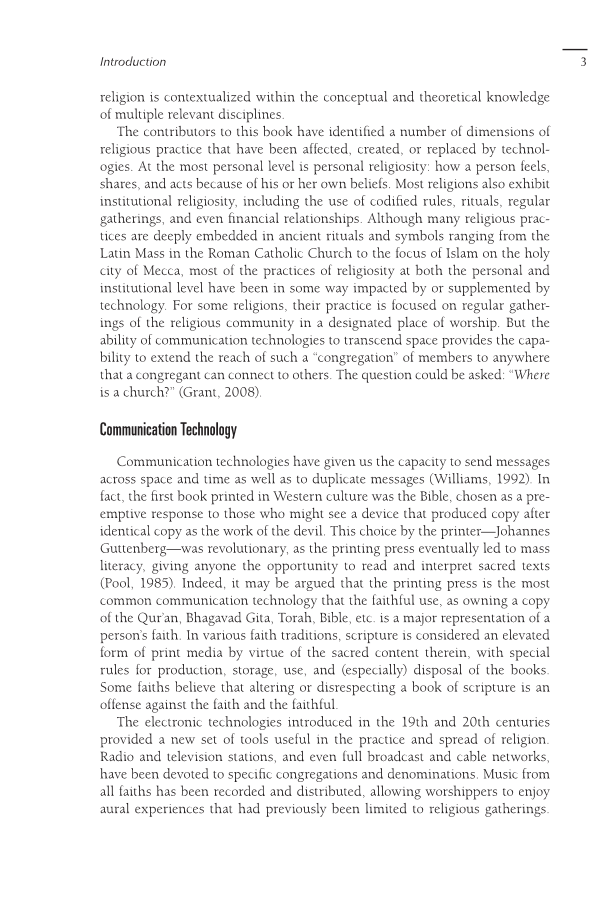Introduction 3 religion is contextualized within the conceptual and theoretical knowledge of multiple relevant disciplines. The contributors to this book have identified a number of dimensions of religious practice that have been affected, created, or replaced by technol- ogies. At the most personal level is personal religiosity: how a person feels, shares, and acts because of his or her own beliefs. Most religions also exhibit institutional religiosity, including the use of codified rules, rituals, regular gatherings, and even financial relationships. Although many religious prac- tices are deeply embedded in ancient rituals and symbols ranging from the Latin Mass in the Roman Catholic Church to the focus of Islam on the holy city of Mecca, most of the practices of religiosity at both the personal and institutional level have been in some way impacted by or supplemented by technology. For some religions, their practice is focused on regular gather- ings of the religious community in a designated place of worship. But the ability of communication technologies to transcend space provides the capa- bility to extend the reach of such a “congregation” of members to anywhere that a congregant can connect to others. The question could be asked: “Where is a church?” (Grant, 2008). Communication Technology Communication technologies have given us the capacity to send messages across space and time as well as to duplicate messages (Williams, 1992). In fact, the first book printed in Western culture was the Bible, chosen as a pre- emptive response to those who might see a device that produced copy after identical copy as the work of the devil. This choice by the printer—Johannes Guttenberg—was revolutionary, as the printing press eventually led to mass literacy, giving anyone the opportunity to read and interpret sacred texts (Pool, 1985). Indeed, it may be argued that the printing press is the most common communication technology that the faithful use, as owning a copy of the Qur’an, Bhagavad Gita, Torah, Bible, etc. is a major representation of a person’s faith. In various faith traditions, scripture is considered an elevated form of print media by virtue of the sacred content therein, with special rules for production, storage, use, and (especially) disposal of the books. Some faiths believe that altering or disrespecting a book of scripture is an offense against the faith and the faithful. The electronic technologies introduced in the 19th and 20th centuries provided a new set of tools useful in the practice and spread of religion. Radio and television stations, and even full broadcast and cable networks, have been devoted to specific congregations and denominations. Music from all faiths has been recorded and distributed, allowing worshippers to enjoy aural experiences that had previously been limited to religious gatherings.
Document Details My Account Print multiple pages
Print
You have printed 0 times in the last 24 hours.
Your print count will reset on at .
You may print 0 more time(s) before then.
You may print a maximum of 0 pages at a time.













































































































































































































































































































































































































































































































































































































































